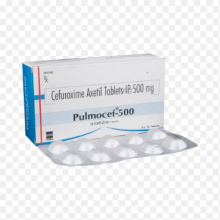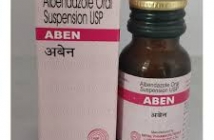Home / Categories / PULMOCEF-500MG

PULMOCEF-500MG
(10X3)
CEFUROXIME-500MG
CEPHALOSPORINS
MICRO LABS LIMITED
Product Details
Cefuroxime
Action
Indications
Contraindications
Route/Dosage
Interactions
Lab Test Interferences
Adverse Reactions
PrecautionsPatient Care Considerations
Administration/Storage
Assessment/Interventions
Patient/Family Education
(SEFF-yur-OX-eem)Ceftin, Kefurox, ZinacefClass: Antibiotic/cephalosporin
 Action Inhibits mucopeptide synthesis in bacterial cell wall.
Action Inhibits mucopeptide synthesis in bacterial cell wall.
 Indications Oral form: Treatment of infections of lower respiratory tract, urinary tract, skin and skin structures; treatment of uncomplicated gonorrhea, otitis media, pharyngitis and tonsillitis due to susceptible strains of specific micro-organisms. Treatment of early Lyme disease, pharyngitis/tonsillitis and impetigo. Parenteral form: Treatment of infections of lower respiratory tract, urinary tract, skin and skin structures, bone and joint; preoperative prophylaxis; treatment of septicemia, gonorrhea and meningitis due to susceptible strains of specific microorganisms.
Indications Oral form: Treatment of infections of lower respiratory tract, urinary tract, skin and skin structures; treatment of uncomplicated gonorrhea, otitis media, pharyngitis and tonsillitis due to susceptible strains of specific micro-organisms. Treatment of early Lyme disease, pharyngitis/tonsillitis and impetigo. Parenteral form: Treatment of infections of lower respiratory tract, urinary tract, skin and skin structures, bone and joint; preoperative prophylaxis; treatment of septicemia, gonorrhea and meningitis due to susceptible strains of specific microorganisms.
 Contraindications Hypersensitivity to cephalosporins.
Contraindications Hypersensitivity to cephalosporins.
 Route/Dosage
Route/Dosage
Infection
ADULTS & CHILDREN ³ 12 YR: PO 125–500 mg bid. IV/IM 750 mg-1.5 g q 8 hr. CHILDREN < 12 YR: PO 125–250 mg bid. Infants & CHILDREN (> 3 MO): IV/IM 50–150 mg/kg/day (not to exceed adult dose) in equally divided doses q 6–8 hr.
Bacterial Meningitis
ADULTS & CHILDREN ³ 12 YR: IV/IM Up to 3 g q 8 hr. INFANTS & CHILDREN 3 MO-12 YR: IV/IM 200–240 mg/kg/day in divided doses q 6–8 hr.
Uncomplicated Gonorrhea
ADULTS & CHILDREN ³ 12 YR: PO 1 g as single dose. IM 1.5 g as single dose.
Preoperative Prophylaxis
ADULTS: IV/IM 1.5 g ½–1 hr before surgery then 750 mg q 8 hr for duration of surgery.
 Interactions
Interactions
Aminoglycosides: Increased risk of nephrotoxicity with parenteral cefuroxime. Probenecid: Inhibition of renal excretion of cefuroxime. INCOMPATIBILITIES: Aminoglycosides: Do not add aminoglycosides to cefuroxime solutions because inactivation of both drugs may result; administer at separate sites if concurrent therapy is indicated.
 Lab Test Interferences May cause false-positive urine glucose test results with Benedict's solution, Fehling's solution, or Clinitest tablets but not with enzyme-based tests (eg, Clinistix, Tes-tape); false-positive test results for proteinuria with acid and denaturization-precipitation tests; false-positive direct Coombs' test results in certain patients (eg, those with azotemia); false elevations in urinary 17-ketosteroid values; false-negative reaction in ferricyanide test for blood glucose.
Lab Test Interferences May cause false-positive urine glucose test results with Benedict's solution, Fehling's solution, or Clinitest tablets but not with enzyme-based tests (eg, Clinistix, Tes-tape); false-positive test results for proteinuria with acid and denaturization-precipitation tests; false-positive direct Coombs' test results in certain patients (eg, those with azotemia); false elevations in urinary 17-ketosteroid values; false-negative reaction in ferricyanide test for blood glucose.
 Adverse Reactions
Adverse Reactions
GI: Nausea; vomiting; diarrhea; anorexia; abdominal pain or cramps; flatulence; colitis, including pseudomembranous colitis. GU: Pyuria; renal dysfunction; dysuria; reversible interstitial nephritis; hematuria; toxic nephropathy. HEMA: Eosinophilia; neutropenia; lymphocytosis; leukocytosis; thrombocytopenia; decreased platelet function; anemia; aplastic anemia; hemorrhage. HEPA: Hepatic dysfunction; abnormal liver function test results. OTHER: Hypersensitivity, including Stevens-Johnson syndrome, erythema multiforme, toxic epidermal necrolysis; candidal overgrowth; serum sickness-like reactions (eg, skin rashes, polyarthritis, arthralgia, fever); phlebitis, thrombophlebitis and pain at injection site.
 Precautions
Precautions
Pregnancy: Category B. Lactation: Excreted in breast milk. Children: Safety and efficacy in children < 3 mo not established. Hypersensitivity: Reactions range from mild to life-threatening. Administer drug with caution to penicillin-sensitive patients due to possible cross-reactivity. Pseudomembranous colitis: Should be considered in patients in whom diarrhea develops. Renal impairment: Use drug with caution in patients with renal impairment. Dosage adjustment based on renal function may be required. Superinfection: May result in bacterial or fungal overgrowth of non-susceptible microorganisms.
PATIENT CARE CONSIDERATIONS
 Administration/Storage
Administration/Storage
- Sodium salt is for parenteral administration. Axetil salt is for oral administration.
- Administer oral form with food to enhance absorption.
- May crush and mix with food or beverages; however, crushed tablets have strong, persistent bitter taste. Consider alternative therapy if children cannot swallow whole tablets.
- Reconstituted solution should be light yellow to amber. Do not administer if solution is cloudy or precipitate is present.
- When giving by IM route, shake IM suspension gently before administration. Aspirate to prevent injection into blood vessel. Inject deeply into large muscle (eg, upper outer quadrant of gluteus muscle or lateral thigh); massage well. Rotate injection sites.
- When giving by IV route, use direct intermittent infusion. Administer slowly over 3–5 min. Change IV sites q 48–72 hr.
- For intermittent IV infusion with Y-type administration set, administer over 30 min. and temporarily stop other solutions at Y-site.
- For continuous infusion, reconstituted solution may be further diluted with D5W or 0.9% Sodium Chloride.
- Reconstituted solution is stable for 24 hr at room temperature. When refrigerated, solution in vials is stable for 48 hr; IV solution is stable for 7 days when refrigerated.
- Completely thaw frozen solution at room temperature before use; do not refreeze.
- Do not add supplementary medication to premixed solution.
- Store sterile powder at room temperature and protect from light.
- Store tablets at room temperature.
 Assessment/Interventions
Assessment/Interventions
- Obtain patient history, including drug history and any known allergies. Note renal impairment and allergy to cephalosporins or penicillins.
- Obtain specimens for culture and sensitivity before beginning therapy and periodically during treatment.
- Monitor renal function carefully during treatment.
- Monitor for signs of infection, especially fever, and for positive response to antibiotic therapy.
- Assess for signs and symptoms of anaphylaxis (shortness of breath, wheezing, laryngeal spasm). Have resuscitation equipment available.
- Assess for signs of superinfection, such as vaginitis or stomatitis.
- Assess for diarrhea with blood or pus, which may be symptom of pseudomembranous colitis. Symptoms may occur after antibiotic treatment.
- Monitor IV site for infiltration, infection and thrombophlebitis.
OVERDOSAGE: SIGNS & SYMPTOMS Seizures
 Patient/Family Education
Patient/Family Education
- Instruct patient to complete full course of therapy.
- Advise patient to take with meals to enhance absorption. If tablet must be crushed, mix with food or beverage.
- Advise parent to contact physician if child is unable to tolerate crushed tablet with food or beverage.
- Remind patient to check body temperature daily. If fever persists for more than a few days or if high fever (> 102°F) or shaking chills are noted, physician should be notified immediately.
- Advise patient to maintain normal fluid intake while using this medication.
- Advise diabetic patient to use enzyme-based tests (eg, Clinistix, Testape) for monitoring urine glucose because drug may give false results with other tests.
- Instruct patient to report these symptoms to physician: nausea, vomiting, diarrhea, skin rash, sore throat, bruising, hives, muscle or joint pain.
- Instruct patient to report signs of superinfection: black “furry” tongue, white patches in mouth, foul-smelling stools, vaginal itching or discharge.
- Warn patient that diarrhea that contains blood or pus may be a sign of serious disorders. Tell patient to seek medical care and not to treat at home.
- Instruct patient to seek emergency care immediately if wheezing or difficulty breathing occurs.
Books@Ovid
Copyright © 2003 Facts and Comparisons
David S. Tatro
A to Z Drug Facts




